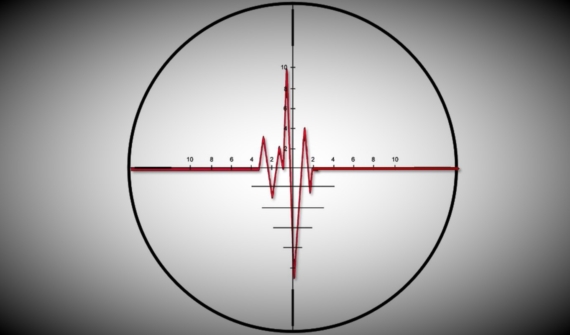An Unprecedented Jump In The VIX

While stocks have hit the skids a bit in the past few days, by comparison, volatility expectations have soared by an unprecedented amount.
A few days ago, many stock indices were knocking on the door of new all-time highs. They have sold off a bit in the few days since. However, the real story is in the volatility market. There, we see that, despite the rather moderate stock market losses in recent days – not to mention the rather close proximity still to new highs – volatility expectations have soared by an unprecedented amount, by some measures.
What does this relatively out-sized move in the volatility market tell us about current and future markets? We’re really not quite sure. And rather than opine about the possible ramifications, this post is simply going to list a few of the milestones reached by the S&P 500 Volatility Index, a.k.a., VIX, over the past few days. We’ll also present some historical stock market and volatility performance statistics based on circumstances somewhat akin to the milestone figures.
First off, what kind of jump are we talking about in the VIX? This chart lists some of the unprecedented (or nearly so) measurements of the past few days.
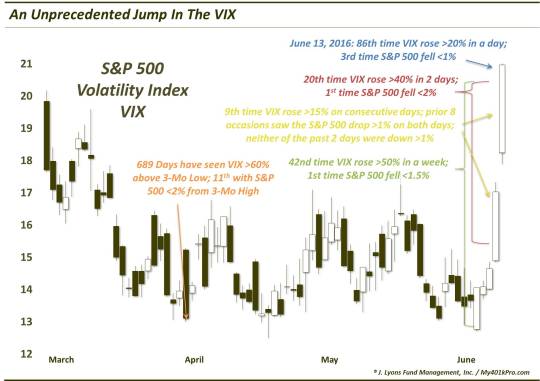
To wit:
1) June 13, 2016 marked the 86th time in which the VIX rose >20% in a day; of those days, it was just the 3rd time in which the S&P 500 fell <1%.
Yesterday, the VIX rose 23% while the S&P 500 fell by only -0.8%. Only 8/11/1987 and 12/8/2014 saw the S&P 500 fall by less than 1% when the VIX was up over 20%. The following table shows subsequent S&P 500 and VIX performance following days when the VIX rises by >20% and the S&P 500 drops by <2%. For what it’s worth, the S&P 500 managed to bounce back rather consistently over the short to intermediate-term, though returns were muted. Perhaps the most consistent result was the tendency of the VIX to fall back in the short to intermediate-term.

2) This marked the 42nd time in which the VIX rose >50% in a week; it was the 1st such time in which the S&P 500 fell <1.5%.
Over the past week, the VIX rose 54% while the S&P fell by only -1.4%. The following table shows S&P 500 and VIX performance following weeks when the VIX rises by >50% and the S&P 500 drops by <5%. Like the prior table, the S&P 500 managed to bounce back rather consistently but not overly impressively over the short to intermediate-term. Also similar to the 1st table was the performance the VIX in its tendency to drop back down in the short to intermediate-term.
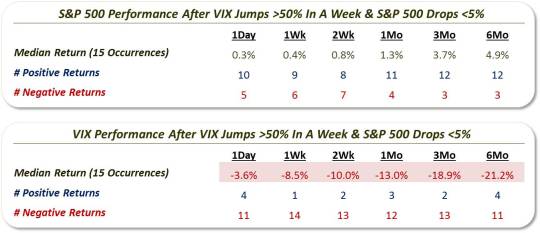
3) The past 2 days marked the 20th time the VIX rose >40% in 2 days; this is the 1st such time in which the S&P 500 fell <2%.
Over the past 2 days, the VIX has risen by 43%. This was the first 2-day 40% rise, out of 20, that saw the S&P 500 fall by less than 2%. The following table shows subsequent S&P 500 and VIX performance following the previous 19 2-day jumps in the VIX of >40%. More so than even the prior tables, S&P 500 managed to bounce back rather consistently over the short to intermediate-term. Also exceedingly consistent was the tendency of the VIX to fall back in the short to intermediate-term. These results are likely due to much more calamitous circumstances in the market than we’ve seen in the past few days (indeed, the S&P 500 was down an average of -6.5% during the prior 19 occurrences).
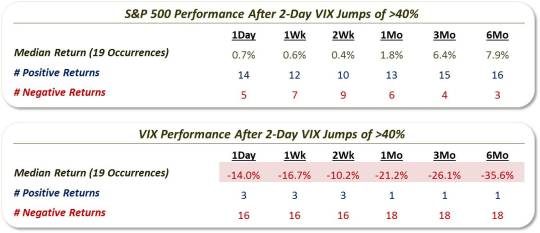
4) This was the 9th time that the VIX rose >15% on consecutive days; during the prior 8 occasions, the S&P 500 dropped >1% on both days while, this time, neither of the past 2 days were down >1%.
While the VIX was up 23% and 16% respectively over the past 2 days, neither of the days saw the S&P 500 lose as much as 1%. During each of the prior 8 2-day streaks of 15% jumps in the VIX, the S&P 500 fell more than 1% on each of the days. Again, the S&P 500 managed to bounce back consistently, and rather strongly this time, over the short to intermediate-term. Also, the VIX almost unanimously fell back in the short to intermediate-term. Again, these results follow more calamitous circumstances in the market (i.e., an average loss in the S&P 500 of -7.5%) than we’ve seen in the past few days. Therefore, the extent to which the precedents can be applied to our present case is up for debate.

5) After yesterday, 689 Days since 1986 have seen the VIX close more than 60% above its 3-month low; this is just the 11th such day with the S&P 500 <2% from its 3-month high.
While the VIX is now 60% above its 3-month low, the S&P 500 is still just 1.9% away from its 3-month high. Of the 689 days that have seen the VIX that far above its 3-month low, this is just the 11th day with the S&P 500 sitting less than 2% away from its 3-month high. The other days all occurred in early 1996 and December 2014. From what can be gleaned from 2 precedents (if anything), stocks dropped in the short-term before bouncing back in the intermediate-term following the prior events. Meanwhile, the VIX continued to chop about in the short-term before falling back in the intermediate-term.
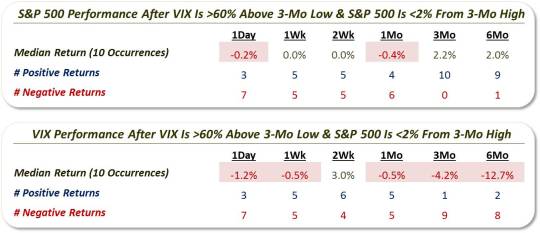
The extent to which historical precedents can provide guidance as to expected future behavior in financial markets is a much-debated topic. The random market theorists would say it is bunk. We believe that not only can historical references be of assistance but there are cyclical tendencies that have much more to do with market behavior than contemporary news and economic events, etc. Sometimes, however, we run into circumstances that do not allow for analysis of historical precedents – because there are none. That is what we are facing in this situation with the out-sized rise in the VIX.
While we have tried to find similar historical situations, this move is truly unprecedented. Therefore, we would caution against trying to closely apply any of the statistical findings in this post to present circumstances. Rather, we will continue to rely on our standard, proprietary models, as always, in analyzing present conditions and simply marvel at a market that continues to come up with surprises.
_____________
Photo of Dick Fosbury using his signature “Fosbury Flop” to set a new Olympic record in the high jump at the 1968 Olympic Games in Mexico City.
More from Dana Lyons, JLFMI and My401kPro.
The commentary included in this blog is provided for informational purposes only. It does not constitute a recommendation to invest in any specific investment product or service. Proper due diligence should be performed before investing in any investment vehicle. There is a risk of loss involved in all investments.
